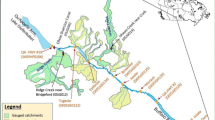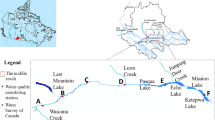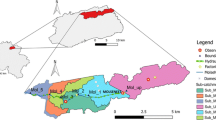Abstract
Little is known about seasonal differences (ice-on vs. ice-off periods) and the sensitivity of in-stream processes to surface water quality constituents in rivers that have a persistent ice cover in winter. The goal of this study is to investigate the sensitivity of nutrient transformation processes on surface water quality, especially rivers in cold regions where ice-covered conditions persist for a substantial part of the year. We established a sensitivity analysis framework for water quality modelling and monitoring of rivers in cold regions using the Water Quality Analysis Program WASP7. The lower South Saskatchewan River in the interior of western Canada, from the Gardiner Dam at Lake Diefenbaker to the confluence of the North and South Saskatchewan rivers, is used as a test case for this purpose. The study reveals that parameter sensitivities differ between ice-covered and ice-free periods and biological model parameters related to nutrient-phytoplankton dynamics can still be sensitive during the ice-covered season. For example, sediment oxygen demand is an important parameter during the ice-on period, whereas parameters related to nitrification are more sensitive in the ice-off period. These results provide insight into important water quality monitoring aspects in cold regions during different seasons.

















Similar content being viewed by others
References
Withers, P. J. A., & Jarvie, H. P. (2008). Delivery and cycling of phosphorus in rivers: a review. Science of the Total Environment, 400(1), 379–395.
Gober, P., & Wheater, H. (2013). Socio-hydrology and the science-policy interface: a case study of the Saskatchewan River Basin. Hydrology and Earth System Sciences – Discussion, 10(5), 6669–6693.
Byrne, J., Kienzle, S., Johnson, S., Duke, D., Gannon, G., & Selinger, V. (2006). Current and future water issues in the Oldman River Basin of Alberta, Canada. Water Science and Technology, 53(10), 327–334.
Koning, C. W., Saffran, K. A., Little, J. L., & Fent, L. (2006). Water quality monitoring: the basis for watershed management in the Oldman River Basin, Canada. Water Science and Technology, 53(10), 153–161.
Ruszchi C. (2010) Water quality in the South Saskatchewan River Sub-Basin. SEAWA Web-based State of the Watershed Report. University of Alberta
Xing, F., & Stefan, G. H. (1997). Simulated climate change effects on dissolved oxygen characteristics in ice-covered lakes. Ecological Modelling, 103(2), 209–229.
Shakibaeinia A, Dibike YB, Prowse TD. (2014) Numerical modelling of dissolved-oxygen in a cold-region river. In: International Environmental Modelling and Software Society (iEMSs) 7th Intl. Congress on Env. Modelling and Software. San Diego, CA, USA
Prowse, T. D. (2001). River-ice ecology. I: Hydrologic, geomorphic, and water-quality aspects. Journal of Cold Regions Engineering, 15(1), 1–16.
Weyhenmeyer, G. A., Westoo, A. K., & Willen, E. (2008). Increasingly ice-free winters and their effects on water. Hydrobiologia, 599(1), 111–118.
Ambrose RB, Wool TA, Connolly JP, Schanz RW. (1988) WASP4, a hydrodynamic and water-quality model-model theory, user’s manual, and programmer’s guide. Environmental Protection Agency, Athens, GA (USA). Environmental Research Lab. 1988 No. PB-88-185095/XAB; EPA-600/3–87/039
Wool, T. A., Davie, S. R., & Rodriguez, H. N. (2003). Development of three-dimensional hydrodynamic and water quality models to support total maximum daily load decision process for the Neuse River Estuary, North Carolina. Journal of Water Resources Planning and Management, 129(4), 295–306.
Pastres, R., Franco, D., Pecenik, G., Solidoro, C., & Dejak, C. (1997). Local sensitivity analysis of a distributed parameters water quality model. Reliability Engineering and System Safety, 57, 21–30.
Van Griensven, A., Meixner, T., Grunwald, S., Bishop, T., Diluzio, M., & Srinivasan, R. (2006). A global sensitivity analysis tool for the parameters of multi-variable catchment models. Journal of Hydrology, 324(1), 10–23.
Razavi, S., & Gupta, H. V. (2015). What do we mean by sensitivity analysis? The need for comprehensive characterization of “global” sensitivity in Earth and Environmental systems models. Water Resources Research, 51(5), 3070--3092.
Lindenschmidt, K. E., Pech, I., & Baborowski, M. (2009). Environmental risk of dissolved oxygen depletion of diverted flood waters in river polder systems—a quasi-2D flood modelling approach. Science of the Total Environment, 407(5), 1598–1612.
Lindenschmidt, K. E., Huang, S., & Baborowski, M. (2008). A quasi-2D flood modelling approach to simulate substance transport in polder systems for environmental flood risk assessment. Science of the Total Environment, 397(1–3), 86–102.
Mann, H. (1945). Nonparametric tests against trend. Econometrica, 13(3), 245–259.
Kendall, M. (1975). Correlation methods (p. 196). Charles Griffin: London.
Sen, P. (1968). Estimates of the regression coefficient based on Kendall’s tau. Journal of the 475 American Statistical Association, 63(324), 1379–1389.
Zhang, X., Vincent, L. A., Hogg, W. D., & Niitsoo, A. (2000). Temperature and precipitation trends in Canada during the 20th century. Atmosphere-Ocean, 38(3), 395–429.
Di Toro DM, Fitzpatrick JJ, Thomann RV. (1983) Water Quality Analysis Simulation Program (WASP) and Model Verification Program (MVP) documentation. User’s manual.
Connolly JP, Winfield R. (1984) A user’s guide for WASTOX, a framework for modeling the fate of toxic chemicals in aquatic environments. Part 1: exposure concentration. EPA-600/3–84-077. Gulf Breeze: USEPA.
Lindenschmidt, K. E. (2006). The effect of complexity on parameter sensitivity and model uncertainty in river water quality modelling. Ecological Modelling, 190(1), 72–86.
Kaufman GB. (2003) Application of the Water Quality Analysis Simulation Program (WASP) to evaluate dissolved nitrogen concentrations in the Altamaha River Estuary, Georgia. Master Thesis. B.S., University of Florida.
Franceschini, S., & Tsai, C. W. (2010). Assessment of uncertainty sources in water quality modeling in the Niagara River. Advances in Water Resources, 33, 493–503.
Diduck, S. (1989). Water quality modelling South Saskatchewan River. Technical Report D.10. Regina, Saskatchewan: Saskatchewan Environment and Public Safety; Water Quality Branch Saskatchewan Environment and Public Safety.
Armengol, J., Caputo, L., Comerma, M., Eijoó, C., García, J. C., Marcé, R., Navarro, E., & Ordoñez, J. (2003). Sau reservoir’s light climate: relationships between Secchi depth. Limnetica, 22(1–2), 195–210.
Poole, H. H., & Atkins, W. R. (1929). Photo-electric measurements of submarine illumination throughout the year. Journal of the Marine Biological Association of the United Kingdom (New Series), 16(1), 297–324.
Chapra, S. C. (1997). Surface water-quality modeling. New York: McGraw-Hill.
Tufford, D. L., & McKellar, H. N. (1999). Spatial and temporal hydrodynamic and water quality modeling analysis of a large reservoir on the South Carolina (USA) coastal plain. Ecological Modelling, 114, 137–173.
Tang, Y., Reed, P., Wagener, T., & Werkhoven, K. V. (2007). Comparing sensitivity analysis methods to advance lumped. Hydrology and Earth System Sciences, 11, 793–817.
Shannon, C. E. (1948). A mathematical theory of communication. Bell System Technical Journal, 27, 379–423.
Gupta, H., Wagener, T., & Liu, Y. (2008). Reconciling theory with observations: elements of a diagnostic approach to model evaluation. Hydrological Processes, 22(18), 3802–3813.
Weijs, S. V., Schoups, G., & Giesen, N. V. D. (2010). Why hydrological predictions should be evaluated using information theory. Hydrology and Earth System Sciences, 14(EPFL-ARTICLE-167375), 2545–2558.
Pechlivanidis, I. G., Jackson, B., McMillan, H., Gupta, H., Pechlivandis, I. G., et al. (2012). Using an informational entropy-based metric as a diagnostic of flow duration to drive model parameter identification. In the special issue of the Global NEST. Journal on Hydrology and Water Resources, 14(3), 325–333.
Chun, K. P., Wheater, H., & Onof, C. (2012). Prediction of the impact of climate change on drought: an evaluation of six UK catchments using two stochastic approaches. Hydrological Processes, 27, 1600–1614. doi:10.1002/hyp.9259.
Boyd S, Vandenberghe L. (2004) Convex optimization. Cambridge University Press.
MacKay. (2003) Information theory, inference, and learning algorithms. Cambridge University Press.
Hudson, J. (2015). Spatial and temporal patterns in physical properties and dissolved oxygen in Lake Diefenbaker, a large reservoir on the Canadian prairies. Journal of Great Lakes Research, 41, 22–33.
Shrestha, R. R., Osenbrück, K., & Rode, M. (2013). Assessment of catchment response and calibration of a hydrological model using high-frequency discharge–nitrate concentration data. Hydrology Research, 44(6), 995–1012.
Shakibaeinia, A., Kashyap, S., Dibike, Y. B., & Prowse, T. D. (2016). An integrated numerical framework for water quality modelling in cold-region rivers: a case of the lower Athabasca River. Science of the Total Environment, 569, 634–646.
Bongartz, K., Steele, T. D., Baborowski, M., & Lindenschmidt, K. E. (2007). Monitoring, assessment and modelling using water quality data in the Saale River Basin, Germany. Environmental Monitoring and Assessment, 135(1–3), 227–240.
Ji, Z. G. (2008). Hydrodynamics and water quality: modeling rivers, lakes, and estuaries. New Jersey: Wiley.
Carr, G. M., & Chambers, P. A. (1998). Macrophyte growth and sediment phosphorus and nitrogen in a Canadian prairie river. Freshwater Biology, 39(3), 525–536.
Tones, P., Waite, D., & Fast, D. (1980). Report on nutrient Imo Acton South Saskatchewan River. Saskatoon: Water Pollution Control Branch, Saskatchewan Environment WPC-25A and WPC-25B.
Chambers, P. (1993). Nutrient dynamics and aquatic plant growth: the case of the South Saskatchewan River. Saskatoon: Environment Canada; National Hydrology Research Institute, Environment Canada NHRI Contribution No. 93001.
Constable, M. (2001). Ecological survey of the South Saskatchewan River downstream of the City of Saskatoon wastewater treatment plant. EPS 5/AT/2. Edmonton: Environmental Protection Branch, Environment Canada; Environmental Protection Branch Prairie and Northern Region, Environment Canada EPS 5/AT/2.
Acknowledgements
The authors acknowledge the Water Security Agency and the Saskatchewan Ministry of Environment for providing data used in this study. They also thank the Global Institute for Water Security and the University of Saskatchewan for funding this project.
Author information
Authors and Affiliations
Corresponding author
Rights and permissions
About this article
Cite this article
Hosseini, N., Chun, K.P., Wheater, H. et al. Parameter Sensitivity of a Surface Water Quality Model of the Lower South Saskatchewan River—Comparison Between Ice-On and Ice-Off Periods. Environ Model Assess 22, 291–307 (2017). https://doi.org/10.1007/s10666-016-9541-3
Received:
Accepted:
Published:
Issue Date:
DOI: https://doi.org/10.1007/s10666-016-9541-3




